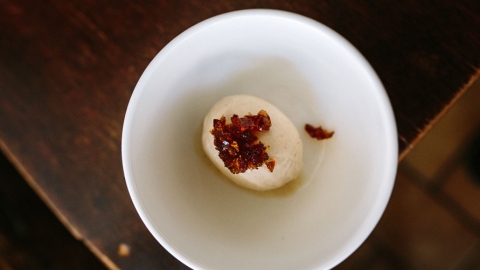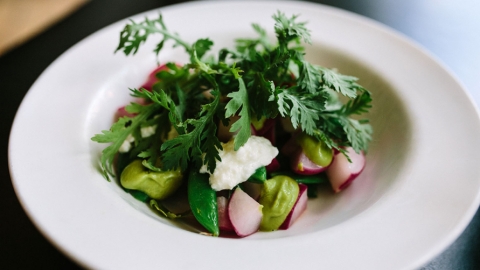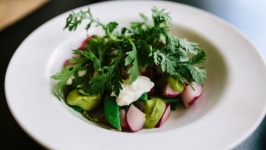Instructions
4 to 5 medium-sized heirloom tomatoes (we use Aldergrove Farm tomatoes)
1 to 2 bunches of herbs (a mix of Mexican mint marigold, basil, mint, nasturtium, rosemary flowers, sage, parsley, tomato leaf and coriander)
4 to 6 starchy potatoes, such as Yukon Gold or Russet
1 yellow pepper
Habanero pepper
Wash and cut the tomatoes into quarters. Salt any cut side and allow the salt to penetrate for a couple of minutes. You usually need to be a little heavier with salt on tomatoes, but season to your taste.
Wash and dry the herbs. Go heavier on the lighter flavoured herbs, such as parsley and tomato leaf; lighter and smaller pieces for strong herbs, such as sage and coriander, to avoid an overwhelming bite.
The time to ferment the peppers can be lengthy and can be omitted for a bit of good vinegar or a favourite hot sauce.
Fermented yellow pepper
1000 grams of yellow peppers
30 grams of salt
Wash, halve and remove the seeds and stem from the peppers, then cut into smaller pieces. The smaller they are, the easier they will blend.
Combine salt and peppers in blender and blend on high until puréed. Transfer the pepper purée into food-safe container (consider you will need a container large enough to fill it half way, as the mixture will rise during fermentation). Cover with a cloth or linen.
Stir the purée two to three times a day (morning, afternoon and night) for four days. If you don't stir it, the purée will be susceptible to unwanted mould growth. You may even notice some light bubbling. The goal is to take the simple sweetness of the peppers to somewhere more complex, but not sour the mixture.
Fermented Habanero
1000 grams of habanero
1000 grams of water
60 grams of salt
When the habaneros come in season we will create a base and ferment them for 6 to 9 months.
This is our method: Combine the water and salt in a food-safe container, stir until the salt dissolves. Wash and halve the habaneros (good idea to wear gloves for this) and submerge them into the salt-water solution. Weigh the habanero down so it stays submerged in brine. Cover with a cloth or linen. Let time do its thing.
Fermented hot sauce
500 grams fermented yellow pepper
10 grams fermented habenero
100 grams cold pressed canola oil
Combine all ingredients into blender, blend on high speed for 1 minute.
Potato crisp
500 grams potato
0.8 per cent salt, based on final weight
Peel and cut potatoes as if you were making mashed potatoes. In a pot large enough to hold the potatoes, cook them in simmering water without salt until the potatoes are overcooked and falling apart.
Strain potatoes, saving the water. Weigh the potatoes. Add the potatoes to a blender and add the same weight of potato water to blender. Add 0.8 per cent salt based on the weight of potatoes and potato water. Blend on high for 5 minutes, which seems like a long time, but you need to work the starch in the potato.
Strain mixture onto a baking sheet in a paper-thin layer. Dehydrate the potatoes in a preheated oven set to 140F until the potato is fully dried and it snaps like a cracker. This can take 12 to 24 hours depending on thickness.
Break off pieces of the dried potato and deep-fry them at 350F until light golden brown.
To assemble, put a bit of hot sauce on the bottom of the plate, top with the seasoned tomatoes and hand-torn pieces of herbs and finish with crisp potatoes.










